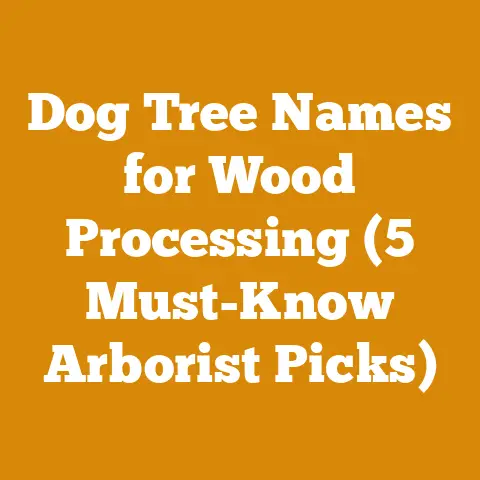How Much for a Ton of Wood Pellets? (5 Insider Pricing Tips)
The wood pellet market, like the seasons themselves, is always in flux. Over the last few years, I’ve seen prices swing wildly, influenced by everything from global energy demand to local weather patterns. It’s a trend that affects everyone, from homeowners heating their houses to businesses powering their operations. So, let’s dive into the heart of the matter: “How Much for a Ton of Wood Pellets? (5 Insider Pricing Tips).” This isn’t just about numbers; it’s about understanding the market dynamics, making informed decisions, and getting the most bang for your buck.
Decoding the Price of Wood Pellets: A Deep Dive
Understanding the cost of wood pellets involves much more than just looking at the price tag. It’s a blend of market forces, product quality, and your own specific needs. Having spent years working with wood – from felling trees to processing firewood and, yes, using wood pellets for heating – I’ve learned that knowledge is your best tool in navigating this market.
The Price Spectrum: What to Expect
Generally, the price of a ton of wood pellets can range anywhere from $200 to $400 or even higher. This range is broad because it’s influenced by several factors:
- Location: Prices vary significantly depending on where you are. Areas with abundant forests and pellet production facilities often have lower prices.
- Season: Demand peaks in the fall and winter, driving prices up. Buying in the off-season (spring or summer) can save you a considerable amount.
- Quality: Premium pellets, made from 100% hardwood and with low ash content, typically cost more.
- Quantity: Buying in bulk (a ton or more) usually gets you a better price per bag than buying individual bags.
- Retailer: Big box stores, local hardware stores, and direct-from-manufacturer options all have different pricing structures.
Regional Price Variations: A North American Snapshot
To illustrate the regional differences, let’s look at some typical price ranges in North America (as of late 2023/early 2024 – remember prices can change!):
- Northeast: $280 – $380 per ton. High demand due to cold winters and reliance on wood pellet stoves.
- Southeast: $250 – $350 per ton. Moderate demand, often lower due to proximity to pellet production facilities.
- Midwest: $220 – $320 per ton. Similar to the Southeast, with some areas benefiting from local production.
- West: $260 – $400+ per ton. Prices can be higher in remote areas due to transportation costs.
These are just estimates, of course. Always check with local retailers for the most up-to-date pricing in your area.
Factors Influencing Wood Pellet Prices
Several key factors affect the overall price of wood pellets:
- Raw Material Costs: The price of wood fiber (sawdust, wood chips) is a primary driver. Fluctuations in the lumber industry can impact this.
- Energy Costs: Manufacturing pellets requires energy. Rising energy costs translate to higher pellet prices.
- Transportation Costs: Shipping pellets from the manufacturing plant to the retailer adds to the cost. Fuel prices and distance play a significant role.
- Supply and Demand: As mentioned earlier, seasonal demand is a major factor. But unexpected events, like extreme weather, can also disrupt supply and drive prices up.
- Government Regulations: Environmental regulations and incentives can impact both production costs and demand.
5 Insider Pricing Tips to Save Money on Wood Pellets
Alright, let’s get down to the nitty-gritty. Here are five insider tips I’ve learned over the years to help you save money on wood pellets:
1. Buy in the Off-Season: Timing is Everything
This is perhaps the most straightforward tip, but it’s worth emphasizing. Just like buying Christmas decorations in January, buying wood pellets in the spring or summer can save you a significant amount of money. Demand is low, retailers are looking to clear out inventory, and you can often find discounts of 10-20% or even more.
Personal Story: I remember one year, back in 2015, I stocked up on wood pellets in July for just $180 a ton. By December, the price had jumped to over $300! That single decision saved me hundreds of dollars.
Actionable Tip: Start looking for deals in late spring (May/June) and continue monitoring prices throughout the summer. Don’t wait until the last minute!
2. Consider Bulk Buying: More is Cheaper (Usually)
Buying in bulk – a ton or more – almost always gets you a better price per bag than buying individual bags. This is because retailers save on handling and packaging costs when selling in bulk.
Data Point: A typical 40-lb bag of wood pellets might cost $6-8 when purchased individually. But buying a ton (50 bags) could bring the price down to $5-6 per bag, saving you $50-100 per ton.
Practical Advice: If you have the storage space, buying a full pallet (usually one ton) is the way to go. Many retailers offer discounts for pallet purchases.
Challenge: Storage can be an issue. Wood pellets need to be stored in a dry place to prevent them from absorbing moisture and crumbling. A garage, shed, or covered porch works well.
3. Shop Around and Compare Prices: Don’t Settle for the First Offer
This seems obvious, but it’s surprising how many people don’t take the time to shop around. Check prices at big box stores, local hardware stores, and even direct-from-manufacturer options. Don’t be afraid to call around and ask for quotes.
Unique Insight: Direct-from-manufacturer options can sometimes offer the best prices, especially if you live near a pellet production facility. However, you may need to buy in larger quantities (multiple tons) to qualify for these discounts.
Online Resources: Use online price comparison tools and forums to get a sense of the going rate in your area. But be cautious of scams and always verify the legitimacy of the seller before making a purchase.
Word of Caution: Always factor in delivery costs. A seemingly great price might not be so great if the delivery fee is exorbitant.
4. Evaluate Pellet Quality: Cheaper Isn’t Always Better
While saving money is important, don’t sacrifice quality for price. Low-quality pellets can contain more ash, burn less efficiently, and even damage your stove.
Data Point: Premium pellets typically have an ash content of less than 1%, while standard pellets can have an ash content of 3% or more. Higher ash content means more frequent cleaning and potentially reduced stove lifespan.
Wood Species Matters: Hardwood pellets generally burn hotter and longer than softwood pellets. Look for pellets made from oak, maple, or hickory for the best performance.
The Burn Test: A simple way to assess pellet quality is to perform a burn test. Burn a handful of pellets in a safe, controlled environment and observe the ash content and burn characteristics.
My Experience: I once bought a batch of cheap pellets that produced so much ash, I had to clean my stove every day. It was a nightmare! I learned my lesson: quality matters.
5. Negotiate and Haggle: It Never Hurts to Ask
Don’t be afraid to negotiate with retailers, especially if you’re buying in bulk or are a repeat customer. You might be surprised at what you can get.
Negotiation Tactics:
- Mention Competitor Prices: Let the retailer know that you’ve found a better price elsewhere and ask if they can match it.
- Offer to Pay in Cash: Some retailers offer discounts for cash payments.
- Ask for a Volume Discount: If you’re buying a large quantity, ask for a discount.
- Be Polite and Respectful: A little bit of politeness can go a long way.
Real-World Example: I once negotiated a 5% discount on a ton of wood pellets simply by asking if they had any promotions or discounts available. It was a quick and easy way to save some money.
Remember: The worst they can say is no.
Beyond Price: Other Factors to Consider
While price is a major consideration, it’s not the only factor to consider when buying wood pellets. Here are some other important aspects:
Pellet Composition and Ash Content
As mentioned earlier, pellet quality is crucial. Look for pellets with low ash content (ideally less than 1%) and made from 100% hardwood. Avoid pellets that contain additives or binders.
Why Ash Content Matters: High ash content can clog your stove, reduce its efficiency, and require more frequent cleaning. It can also shorten the lifespan of your stove.
Understanding BTU (British Thermal Unit): BTU measures the heat output of a fuel. Higher BTU pellets will produce more heat per pound. Look for pellets with a BTU rating of 8,000 or higher.
Moisture Content and Storage
Wood pellets should be stored in a dry place to prevent them from absorbing moisture. Moisture can cause the pellets to crumble, burn poorly, and even damage your stove.
Ideal Moisture Content: The ideal moisture content for wood pellets is less than 8%.
Storage Solutions: A garage, shed, or covered porch are all good options for storing wood pellets. If storing them outdoors, make sure they are covered with a waterproof tarp.
The Water Test: A simple way to check for moisture content is to place a few pellets in a glass of water. If they quickly absorb water and crumble, they are likely too moist.
Delivery Options and Costs
Consider the delivery options and costs when buying wood pellets. Some retailers offer free delivery for large orders, while others charge a fee.
Delivery Considerations:
- Delivery Area: Make sure the retailer delivers to your area.
- Delivery Time: Ask about the delivery timeframe and make sure it works for you.
- Delivery Method: Find out how the pellets will be delivered (e.g., pallet jack, forklift).
- Unloading Assistance: If you need help unloading the pellets, make sure to arrange it in advance.
My Tip: If you have a truck or trailer, you can save money by picking up the pellets yourself.
Environmental Considerations
Finally, consider the environmental impact of your wood pellet purchase. Look for pellets that are made from sustainably sourced wood and are certified by organizations like the Pellet Fuels Institute (PFI).
Sustainable Sourcing: Choose pellets made from wood waste (sawdust, wood chips) rather than virgin timber.
PFI Certification: PFI certification ensures that the pellets meet certain quality standards and are made from sustainable sources.
Reducing Your Carbon Footprint: Wood pellets are a renewable energy source, but it’s still important to use them efficiently and responsibly.
Case Studies: Real-World Examples of Wood Pellet Pricing
To further illustrate the concepts we’ve discussed, let’s look at a few real-world case studies:
Case Study 1: Homeowner in Maine
- Location: Rural Maine
- Heating Needs: Heating a 1,500 sq ft home with a wood pellet stove
- Challenge: High heating costs and limited storage space
- Solution:
- Bought 3 tons of wood pellets in July for $250/ton (total cost: $750)
- Used a small shed for storage
- Saved over $400 compared to buying pellets in December at $380/ton
Case Study 2: Small Business in Oregon
- Location: Small business in Oregon
- Heating Needs: Heating a 2,000 sq ft office space with a wood pellet furnace
- Challenge: High energy costs and fluctuating pellet prices
- Solution:
- Negotiated a bulk discount with a local pellet manufacturer
- Bought 5 tons of wood pellets for $220/ton (total cost: $1,100)
- Saved over $500 compared to buying pellets from a big box store
Case Study 3: Hobby Farmer in Wisconsin
- Location: Hobby farmer in Wisconsin
- Heating Needs: Heating a small greenhouse with a wood pellet stove
- Challenge: Limited budget and storage space
- Solution:
- Bought individual bags of wood pellets from a local hardware store
- Took advantage of a 10% off coupon
- Spent $300 on wood pellets for the entire winter
Wood Pellet FAQs: Addressing Common Concerns
Let’s address some frequently asked questions about wood pellets:
Q: Are wood pellets a good heating option?
A: Yes, wood pellets are a renewable, cost-effective, and efficient heating option. They produce less pollution than fossil fuels and can save you money on your heating bill.
Q: How do I choose the right wood pellet stove?
A: Consider the size of your home, your heating needs, and your budget. Look for a stove that is EPA-certified and has a high efficiency rating.
Q: How often do I need to clean my wood pellet stove?
A: The frequency of cleaning depends on the quality of the pellets you use and how often you use the stove. Generally, you should clean your stove at least once a week.
Q: Can I burn other types of fuel in my wood pellet stove?
A: No, you should only burn wood pellets in your wood pellet stove. Burning other types of fuel can damage your stove and create a fire hazard.
Q: Where can I find more information about wood pellets and wood pellet stoves?
A: You can find more information on the Pellet Fuels Institute (PFI) website, the EPA website, and from local wood pellet stove retailers.
Conclusion: Making Informed Decisions for a Warmer Winter
Navigating the world of wood pellet prices can seem daunting, but with a little knowledge and planning, you can save money and stay warm all winter long. Remember to buy in the off-season, consider bulk buying, shop around, evaluate pellet quality, and don’t be afraid to negotiate. By following these insider tips, you’ll be well on your way to finding the best deal on wood pellets for your needs.
And remember, it’s not just about the price; it’s about the value. Choosing high-quality pellets that burn efficiently and produce less ash will save you time and money in the long run. So, do your research, ask questions, and make informed decisions. Your wallet – and your warm home – will thank you for it.






